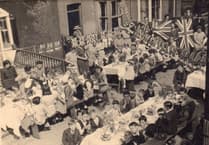A new series of photographs of the long-defunct Longmoor Military Railway between Bordon and Liss has sparked a wave of nostalgia on the Peeps into the Past Facebook page this week.
A recent posting of a contemporary – but un-dated – plan of the railway (pictured right) in particular elicited a flood of memories and stories from those who experienced the railway’s heyday.
One commenter, Stephen Colbourne, reminisced about the line’s open days, describing them as great fun. He fondly remembered being a seven-year-old traveling in a tracked troop transporter to witness a mock battle – and appealed for others to share memories and photos. Another, Dave Cannon, thought the last open day took place in 1969, the year the line closed.
Tim Penycate, a keen observer, noted the map likely dates between 1923 and 1947 owing to the legend ‘SR’ and on the ‘key’ Southern Railway, and added a reproduction of the same plan hangs in The Royal Oak pub in Hollywater.
Another commenter, Christopher Purdie, added more historical context, suggesting that the maximum extent of the Longmoor Military Railway was reached during the Second World War to accommodate the build-up of material, including United States Army Transportation Corps traction, prior to D-Day.
He added the extensive additional sidings at Whitehill and Woolmer were laid during the conflict, citing The Longmoor Military Railway by DW Ronald & RJ Carter, published by David & Charles in 1974. The presence of these sidings in the plan could therefore date it to the latter stages of the Second World War.
The plan also sparked memories of film shoots on the railway tracks, including iconic movies like The Great St Trinian’s Train Robbery and Chitty Chitty Bang Bang.
One commenter, Andrea Denby, added a touch of local history, mentioning that the girls from Alton Convent were used as extras in the St Trinians film. Scenes were also filmed through Greatham, capturing the Altonian school bus in the background.
Ian Permain shared a humorous anecdote from 1957 when the BBC filmed a deliberately derailed locomotive and carriages on an embankment.
“It was an anticlimax as the whole lot simply fell over on its side,” he recalled. “I was taken to see it the following day on our way to Le Court. The film is probably still available on BBC archives.”
Gordon Clark provided a vivid snapshot of watching steam trains in 1952-1953 from the hill where Conford Stores used to be.
And it seems there are still visible remnants of the railway today. EJ Brickowski shared a photo of the old platform at Liss, found on the ‘railway walk’ towards Liss Forest, and Roy Peters added the remains of a railway bridge can be found by Hollywater.
“You can walk around most of the trackway using the perimeter track,” said Roy, before adding sagely, “but not when the ranges are in use!”
He said there is also some evidence of the railway at Weavers Down, but “you will have to look for it and use a lot of imagination”.
Tim Penycate elaborated, saying: “The station platform and shelter at Liss is still standing as is a buffer stop. The latter was erected several years ago and replaced a rather solid block of concrete. The buffer stop is cosmetic as it never existed during operational days.
“A signal gantry exists where the old exchange sidings existed just to the north of Liss.
“An old collapsed concrete signal post lays next to Number 2 Range (the arm was still there in approximately 1997 with the clear legend LMSR on it) but that has gone.
“A old building of inderminate purpose can be seen in the trees near Whitehill.
“The old Milepost 2 was hidden away in the undergrowth until the new A325 was built. It was fashioned from an old sleeper which although well rotted, the number 2 could be made out on the faded yellow paint. It was probably destroyed during the building of the road with no understanding what it was.
“The remnants of a telegraph pole is visible just to the south of Whitehill (where some of the earthworks from the cutting which passed under Whitehill crossroads.
“A few of the old narrow gauge rails were pressed into service as fence posts. Most have gone, but a couple are still visible in the area mentioned above.
“On the Hollywater loop, I think some of the old timbers from Hopkins Bridge are still in the undergrowth!”
Does the plan bring back any memories for you? Or perhaps you have some old photos to share of the line’s open days?
Drop us an email at [email protected]





Comments
This article has no comments yet. Be the first to leave a comment.